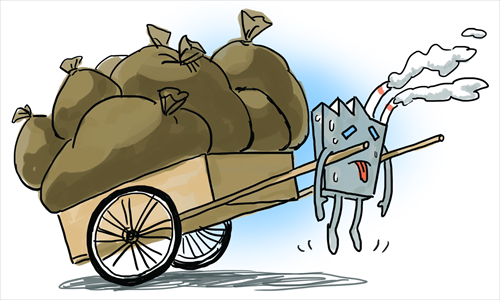HOME >> OP-ED
Faltering Brazil a lesson for Asia
By Ding Gang Source:Global Times Published: 2016-4-20 23:37:40

Illustration: Liu Rui/GT
I started working in Brazil in the summer of 2013, when the country's economy was still booming. But soon I began to feel something wrong with the country.I found that iPhones were sold at a surprisingly high price in Brazil. An iPhone 4 cost over $1,000, which was almost twice the price in the US and could be the most expensive worldwide.
And in monthly rent there was a cleaning charge of about $70 to pay the elderly black women - Brazil's most disadvantaged group - who did the cleaning every week. The cleaning fee was still charged even if you didn't use the service, and the clean ladies must stay in your home for three hours.
The iPhones are expensive because of Brazil's stringent protectionism. Heavy taxes are levied on products that are not manufactured in Brazil. The cleaning charge was to ensure jobs for the underprivileged.
The two charges indicate that Brazil's manufacturing is frail and inadequately open with little competitiveness, and the poor in Brazil depend on relief measures. This puts developing countries like Brazil in a quandary as wilting manufacturing and inflated low-level services combined have eroded economic competitiveness.
Now the previous star of the BRICS is plagued by economic collapse. But analysts mostly focus on political and economic factors, and ignore the unsustainable impetus for development caused by dwindling manufacturing.
Compared to Latin American countries, the Asian economy can drive global development and keep doing fine despite the global slowdown because Asia has a strong manufacturing sector. Economic history shows that industrialization may be the only path that countries, save for very small nations, can take to turn from a low-income nation to a high-income one. Only by manufacturing can the large numbers of the rural poor be offered a way into the middle class. Robust manufacturing can enable these people to become disciplined and well-organized, and strive for their rights through trade unions so that society will develop in a fair manner.
But manufacturing does not depend only on government policies, but also culture. Some countries fail to advance manufacturing because, for cultural reasons, the poor lack the skills or inclination for the grind of manufacturing work. It's hard to imagine that Brazilians will stay at assembly lines for hours every day without a break as Chinese rural young people do.
In the case of Brazil, the government used the profits from raw material exports to subsidize the poor when the economy was dynamic, and even requires the middle-class to do their part, as the cleaning charge shows. But this doesn't fundamentally prompt these people to seek a job and gain skills. Offering relief funds to the poor can secure ballots, but can't raise their status. When the budget gets tight, people will vote with their feet.
Asian countries that haven't been completely industrialized face a similar problem of how to provide a pathway to the middle class for the poor through manufacturing rather than low-level services.
As production drops, China needs to figure out ways to enable part of the reduced labor force to re-enter manufacturing via training and micro credit support instead of looking to shift them into the low-level service industry.
Asian people have a tradition of diligence, which is a basic condition for industrialization. We now need to channel capital into manufacturing by policy, promote industrial openness and circulation, and restructure the industrial chain. This should be a major target of China's "Belt and Road" initiative.
The author is a senior editor with People's Daily, and currently a senior fellow with the Chongyang Institute for Financial Studies at Renmin University of China. dinggang@globaltimes.com.cn
Posted in: Columnists, Viewpoint